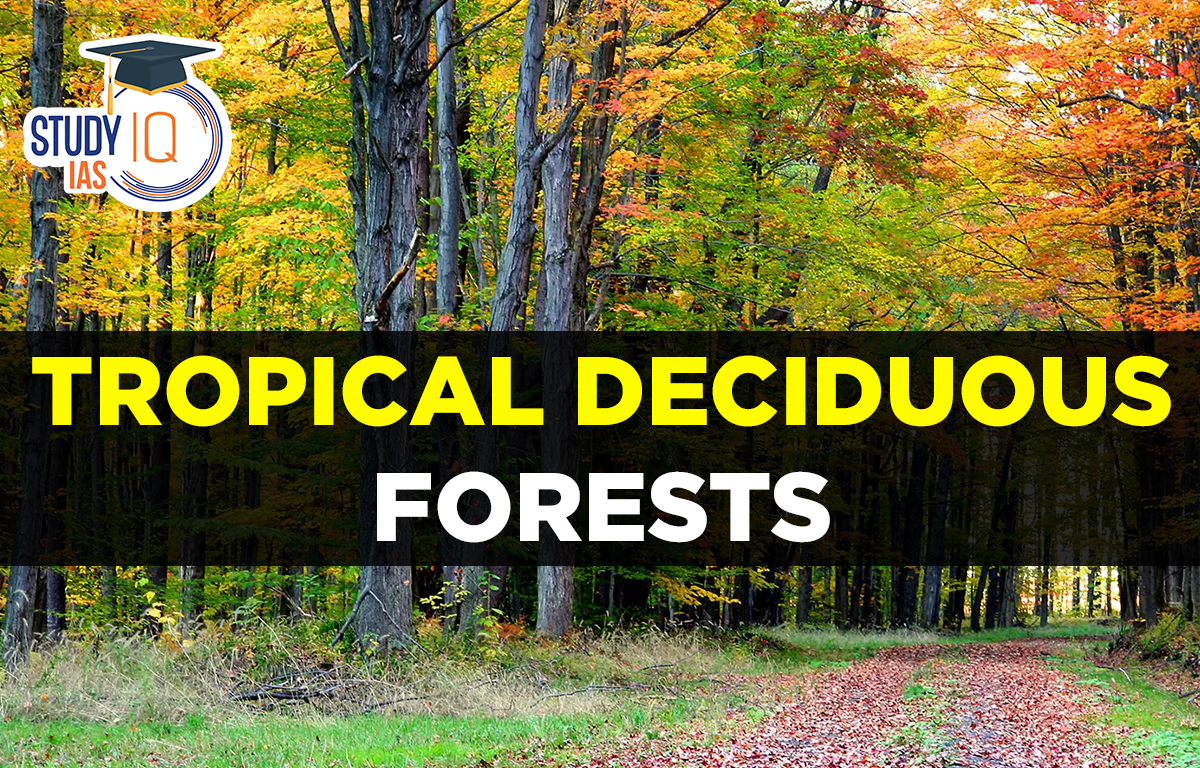Table of Contents
Tropical Deciduous Forests
Forests are an important type of natural vegetation. Depending on the topography and climate, different types of forests exist. Tropical Deciduous Forests are one type. These forests are most common in India. These are India’s most common forests.
Tropical deciduous forests are the most common type of forest in India. They are also known as monsoon forests and are found throughout the region, receiving rainfall ranging from 200 cm to 70 cm. In the dry summer, trees of this forest type shed their leaves for about six to eight weeks. These forests are further classified as moist and dry deciduous based on the availability of water. The former is found in areas with rainfall ranging from 200 to 100 cm.
Read More: Mangrove Forests in India
What are Tropical Deciduous Forests?
Tropical Deciduous Forests grow in areas with heavy rainfall for part of the year followed by a long dry season. During the wet summers, these forest formations are dense and lush, but during the dry winters, when most trees shed their leaves, they become a dry landscape. During dry periods, trees shed their leaves to conserve water. Bare trees open up the canopy layer, allowing sunlight to reach the ground and promoting the growth of dense underbrush.
During the dry seasons, trees drink from underground water. These drastic changes in water availability have a significant impact on the plants and animals that inhabit this ecosystem. During the drought, many deciduous trees lose their leaves, whereas trees in moister areas with access to groundwater tend to remain evergreen.

Read about: Natural Vegetation in India
Tropical Deciduous Forests Characteristics
The term “monsoon forests” refers to Tropical Deciduous Forests. These are India’s most common forests. They are found throughout India, Northern Australia, and Central America. In India, tropical deciduous forests cover nearly 65-66% of the total forest cover area. Because India is a tropical country, tropical deciduous forests are likely to be common.
Because of our country’s geographical location, it experiences very different climatic conditions, supporting a diverse range of natural vegetation in India. Tropical deciduous forests are more likely to be found in areas or regions that receive a lot of rain for part of the year and then have a dry spell for the rest of the year. Rainfall in deciduous forests ranges from 70 to 200 cm.
Tropical deciduous forests grow in warm, year-round climates with hundreds of centimetres of rain per year. Though these forests exist in year-round warm climates and may receive several hundred centimetres of rain per year, they have long dry seasons that last several months and vary depending on geographic location.
Read More: Wildlife Sanctuaries of India
Types of Tropical Deciduous Forests
There are two types of Tropical Deciduous Forests i.e., Tropical Moist Deciduous Forests and Tropical Dry Deciduous Forests.
Tropical Moist Deciduous Forests
Tropical Moist Deciduous Forests are found in areas with an annual rainfall of 200-100cm. The average annual temperature is around 24°C or 27°C, and the relative humidity is between 60% and 75%, which favours this type of vegetation. Moist Deciduous Forests cover approximately 37% of the total percentage. This forest-trees type’s shed its leaves for about six to eight weeks during the dry summer. These are two-layered forests and dry lands that are mostly found in the gaps between the forests.
These forest types can be found in India on the eastern slopes of the Western Ghats and the Chota Nagpur plateau. They can also be found in some areas of Andaman & Nicobar Island, West Odisha, West Bengal, Chhattisgarh, and the North-eastern States along the foothills of the Himalayas, and Jharkhand.
Read More: Types of Soil in India
Tropical Dry Deciduous Forests
Tropical Dry deciduous forests can be found where annual rainfall ranges from 70 to 100 cm. In contrast, dry margins of dry deciduous forests merge into moist deciduous forests, and wet margins of dry deciduous forests merge into thorny vegetation.
Around 28% of the total area of tropical deciduous forests is made up of dry deciduous woods. In order to save water during the dry season, the trees and plants in this forest type shed their leaves. These kinds of forests can be found in North India and the southern Deccan plateau regions. They can be found in the plains of Bihar, Uttar Pradesh, and the peninsular plateau’s rainier northeastern regions. These are unrestricted areas.
Read More: Biodiversity in India
Tropical Deciduous Forest in India Flora & Fauna
Trees like teak, sandalwood, neem, peepal, sal, bamboo, Kusum, Arjun, Khair, and mulberry are found in tropical deciduous forests. Tigers, lions, elephants, foxes, bears, deer, langurs and monkeys are found in deciduous forests.
Read More: Component of Environment
Tropical Deciduous Forest in India Geographical Location
Tropical deciduous forests are found in drier areas north and south of the tropical rainforest belt, as well as south and north of subtropical deserts, in two bands: one between 10° and 20°N latitude and the other between 10° and 20°S latitude. The world’s most diverse dry forests can be found in southern Mexico and the Bolivian lowlands. Because of their dry climate, the dry forests of northwestern South America’s Pacific Coast support a plethora of unique species.
As the name goes, tropical deciduous forests are found along the Equator belt between the tropic of Cancer and the tropic of Capricorn.
Tropical deciduous forests, as the name implies, are found along the Equator belt between the tropics of Cancer and Capricorn. The humidity in these forests ranges between 80 and 90 per cent. The average temperature of tropical deciduous forests is 30 degrees Celsius. Seasonality is a key feature of these forests, as trees shed their leaves during the dry season and regrow them during the rainy season. These forests lose their leaves in the Northern Hemisphere during the winter. These forests are less dense in comparison to evergreen forests.
Major states where tropical deciduous forests are found
- Madhya Pradesh
- Uttar Pradesh
- Chattisgarh
- Odisha
- Maharashtra (Some Parts)
Read More: Environmental Impact Assessment
Tropical Deciduous Forests FAQs
Q) What is a tropical deciduous forest?
Ans. The most common types of forests in India are tropical deciduous forests. They are also known as monsoon woods, and they cover a region that receives between 200 and 70 cm of precipitation annually. During the dry summer, trees in this forest type lose their leaves for roughly six to eight weeks.
Q) What are the main features of tropical deciduous forests?
Ans. These forests are located in areas with annual rainfall ranging from 200 cm to 70 cm. Before winter, the tropical deciduous forests lose their leaves for roughly 1.5 to 2 months. Some evergreen trees keep their leaves all year round.
Q) What are the types of the tropical deciduous forest?
Ans. Moist and Dry Deciduous woods are the two main subtypes of tropical deciduous forests. On the northern section of India and the South Deccan plateau, dry deciduous forests can be found.
Q) What is called a tropical deciduous forest?
Ans. The tropical deciduous forest is also known as the monsoon forest.
Q) What are the types of tropical deciduous forests in India?
Ans. In India, there are two different types of tropical deciduous woods: moist forests and dry forests. They are categorised according to the amount of precipitation and water accessibility.


 Story of Meera Bai and Her Devotion For ...
Story of Meera Bai and Her Devotion For ...
 Desert Climate, Distribution, Climatic C...
Desert Climate, Distribution, Climatic C...
 Deserts of India Map, Features of Thar D...
Deserts of India Map, Features of Thar D...





















